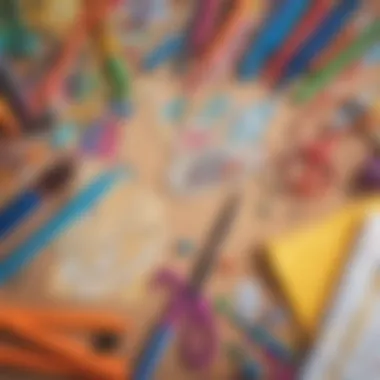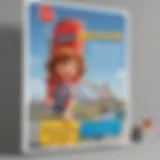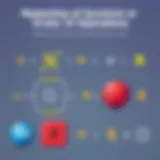Crafting Creative Wanted Signs for Kids


Intro
Crafting a wanted sign offers not only a glimpse into a fascinating piece of history but also serves as a wonderful opportunity for kids to engage their imaginations. Infused with playful elements, this activity is designed with children aged 3 to 12 in mind. It allows them to dive into the world of storytelling while strengthening their creative outbursts.
By the end of this guide, young crafters will have a unique piece of art that tells a story, provides insights into historical contexts, and fosters a sense of accomplishment. The process encourages kids to think critically about what they want to depict, leading to lively discussions and creative brainstorming.
One of the most exciting aspects of this project is how it blends history with a hands-on approach. As parents or educators guide kids through crafting their signs, they can explore together the reasons why wanted signs were created in the past, who created them, and what they represented. All this learning unfolds while keeping the experience fun and engaging.
This guide is tailored to make crafting wanted signs a smooth sailing adventure.
Let's jump right in!
Prologue to Wanted Signs
Creating wanted signs is much more than just a crafty activity. Engaging in this project allows kids to explore their creativity while learning about history, design, and communication. Children, parents, and educators alike can appreciate the history behind wanted signs, helping bring a rich narrative into the present.
A wanted sign traditionally showcases an individual—often a fugitive, a lost pet, or a champion of a community. The blend of art and information encourages not just artistic expression but also critical thinking about how to convey a message clearly and creatively. Kids can put their spin on it, making it personal by incorporating their ideas and stories.
In making wanted signs, children can benefit in several ways:
- Enhanced Creativity: Designing and developing the sign stimulates imagination, allowing each project to be unique.
- Artistic Skills: Learning about colors, fonts, and images helps improve visual arts skills.
- Historical Context: Understanding where this practice comes from can illuminate interesting discussions around law, justice, and community.
Through crafting a wanted sign, kids also develop a deeper appreciation for storytelling and the impact of visuals in communication. Moreover, it can spark conversations around ethics and character traits, especially if they're taking inspiration from real-life events or fictional stories. By the time kids are done creating their sign, they'll not only have a delightful piece of art but also a treasure trove of ideas and skills that they can carry into future projects.
Historical Background
Wanted signs have been around for centuries. They were vital in efforts to locate missing persons and capture fugitives. Back in the Wild West, outlaws were famed figures, sometimes glorified in tales, and their faces appeared on these colorful handbills. The practice of disseminating information through these signs has evolved, but the essence remains the same.
One shouldn't forget to mention that these signs served not only as a method of communication but also as a reflection of the societies where they were used. For instance, in places where law enforcement was scarce, community members relied on these posters to keep their neighborhoods safe. This foundation provides children a framework for understanding the relevance even today, as wanted signs translate into various forms such as social media alerts and digital appeals.
Purpose of Wanted Signs
The fundamental purpose of a wanted sign is to inform the public about someone or something noteworthy. When children create their own signs, the purpose shifts toward self-expression and storytelling. Kids might choose a fictional character or even a lost toy to launch a little adventure. This can be particularly exciting, merging reality with a healthy dose of imagination!
- Gathering Attention: A well-crafted wanted sign grabs attention and demands viewers take notice. It’s all about how you construct your message.
- Information Sharing: Whether looking for a neighbor's cat or fictional superhero, the goal is to effectively communicate and share information with those who might help.
- Building Empathy: By personalizing the content, kids learn to understand perspectives. Asking questions like "Why is this person important?” or “How can I help?” draws them into a broader conversation about care and community.
Ultimately, wanted signs serve as an incredible intersection of art, language, and history, making them an ideal project for children eager to explore their creative capabilities.
Understanding the Concept
Grasping the concept of creating wanted signs is a vital step in this creative journey. Not only do these signs offer a glimpse into history and society, but they also provide children a fun way to express their thoughts and ideas. By understanding what a wanted sign is and how it has been used over time, kids can appreciate its significance beyond mere decoration.
Definition and Use in Society
A wanted sign, traditionally used in the context of law enforcement, serves to alert the public about individuals who are sought after for various reasons—often for committing crimes. However, when children engage in making their signs, they transform this serious concept into a playful and imaginative exercise.
In society, wanted signs perform several functions:
- Awareness: They inform citizens about fugitives and encourage community involvement in keeping neighborhoods safe.
- Creativity: For kids, recreating these signs allows them to think about what makes a character 'wanted'. They can choose topics ranging from woodland creatures that have wandered off to mischievous superheroes.
- Education: Crafting these signs teaches children about message clarity, importance of details, and visual storytelling. It’s a simple way to practice communication skills.
By understanding these facets, children can create signs that not only captivate the viewer’s attention but also carry a narrative filled with creativity and imagination.
Famous Examples of Wanted Signs
Throughout history, there are iconic wanted signs that have left their mark. One of the most notorious examples is the sign for Jesse James, an American outlaw in the 19th century. His wanted poster not only described his physical attributes but also included a sum of money for capturing him. It was this blend of urgency and presentation that brought these signs to life.
Another famous sign comes from the world of fiction: the one for Captain Jack Sparrow from the "Pirates of the Caribbean" series. Though fictional, these posters have inspired countless kids to recreate their own versions, asking questions about who they would like to 'capture' as a fun scenario.


In essence, familiarizing with well-known wanted signs can ignite young minds to develop their unique takes on this age-old tradition.
Understanding these historical and societal uses of wanted signs enriches the crafting experience, allowing children to appreciate the creativity and significance behind their designs.
Preparing to Create Your Sign
Creating a wanted sign isn't just about art; it’s a journey into imagination and learning. When kids roll up their sleeves to prepare for making their own signs, they engage in a series of thoughtful actions that build foundational skills. The process teaches them organization, planning, and problem-solving, creating a delightful balance between creativity and structure.
The crux of this preparation phase hinges on two main elements: the materials selected and how the workspace is set up. Understanding the significance of each item can cultivate an awareness of available resources, encouraging kids to be resourceful. Notably, they learn that every component—from the paper to the colors—plays a vital role in bringing their vision to life.
Especially for younger creators, having a tidy and dedicated workspace allows them to focus better, minimizing distractions. This preparation nurtures an environment where creativity can flourish, sparking excitement about the project ahead. It allows for a smoother sailing experience once the actual crafting begins, laying down a solid foundation for a successful and enjoyable endeavor.
Materials Needed
Before diving into crafting, one must gather all necessary materials. Depending on what kids want to express, the items can vary, but let’s break down the essentials:
- Paper: Can be plain white, colored, or even textured. Bigger sheets allow for more ambitious designs.
- Markers or Crayons: A range of colors enriches the creative palette. These tools can range from fine-tipped markers to chunky crayons for different styles.
- Scissors: Safety scissors are perfect for younger kids, ensuring they stay safe while exploring their creativity.
- Glue or Tape: Adhesives are crucial for fixing various elements together—be it paper, images, or embellishments.
- Stickers or Cut-Out Images: These can add an exciting visual twist, making the sign pop with personality.
- Ruler: Having straight lines is often more visually appealing and helps kids learn about measurement as they create their designs.
- Decorative Items: Think glitter, ribbons, or washi tape that can enhance the overall look of their sign.
"The best journeys answer questions that in the beginning, you didn’t even think to ask."
This quote resonates well here, as gathering materials encourages kids to think creatively about what can make their sign unique.
Setting Up Your Workspace
Now that all materials are in hand, the next step is setting up a workspace that fosters creativity and focus. The workspace should be both functional and inspiring. Here are some helpful tips on how to prepare:
- Find a Good Spot: Choose an area with good lighting and enough space to lay everything out comfortably. A kitchen table or a craft corner works wonders.
- Lay Down a Cover: Protect the surface with newspaper or a plastic tablecloth. This way, any spills or stray marks don't become an issue.
- Organize Materials: Arrange all materials within reach, so nothing is more than an arm's length away. This arrangement prevents disruption during the creative process and keeps the flow intact.
- Personal Touch: Allow kids to decorate their workspace in a way that excites them. Perhaps add a drawing or a quote nearby that inspires. Personalizing their space can significantly boost enthusiasm and motivation.
- Create a Cleanup Plan: Make sure to have a designated area for all the materials. After the project, kids can learn about responsibility by cleaning their area into a tidy condition.
By prepping a dedicated workspace, children develop not only practical crafting skills but also a sense of ownership in their creative process. It's an experience where the mundane transforms into magical, and every little detail counts towards the final masterpiece.
Step-by-Step Instructions
Creating a wanted sign is not just about slapping together some paper and markers. It's a journey, one that allows kids to harness their creative potential while learning to follow a plan. This section presents a detailed roadmap outlining how to craft a compelling sign that is visually engaging and meaningful. Taking each step seriously fosters a sense of accomplishment and nurtures problem-solving skills, which are essential in both artistic endeavors and everyday life.
When children engage in this process, they learn the importance of planning, precision, and creativity, making each step crucial in turning their visions into reality.
Sketching the Design
The journey begins with an idea. Sketching the design is where imagination comes into play. Children can grab a pencil and paper to draft how they envision their sign. Here, it’s not about perfection. It’s about allowing their thoughts to flow onto the paper. This initial sketch is the foundation upon which the final sign rests.
- Encourage Creativity: Suggest they think about the character or theme they want to depict. A light-hearted cowboy or an elusive animal can spark joy and excitement.
- Basic Shapes First: Start with basic geometric shapes to outline the design. This practice helps younger kids break down complex ideas into manageable parts.
- Composition Matters: Talk about where elements should go. Having the main character in the center, or choosing a fun border can greatly affect the visual appeal. This is the moment to get their ideas down without worrying about details.
Choosing Colors and Fonts
Colors and fonts can make or break the appeal of the wanted sign. Once kids have their sketches, it’s time to think about how to bring their designs to life with vivid colors and playful fonts.
- Vibrant Palette: Encourage selecting bright, eye-catching colors. Colors like red or yellow can convey urgency and grab attention.
- Font Selection: Discuss how different fonts convey different messages. Bold sans-serif for a strong character or whimsical handwritten style for a playful tone. Kids might even create their own font styles—an extension of their personal branding!
- Contrast is Key: Teach the concept of contrasting colors for legibility. White letters on a darker background or vice versa can help their message stand out.
Adding Images or Illustrations
Now for the fun part! Adding images or illustrations can elevate a simple sign into artwork. This section emphasizes creativity and personal expression through images.
- Illustrate the Characters: Kids can draw their characters, but they can also find pictures to cut out from magazines or print from online sources, provided they have permission to do so.
- Think Outside the Box: Use various textures. For example, cotton for clouds or fabric for clothing adds a tactile element to their artwork.
- Story through Images: Engage them by discussing what story their sign tells. Are they depicting a wanted character that has been up to amusing antics? Using illustrations wisely can narrate their tale even without words.
Final Touches
Every good project deserves a finishing flourish. Final touches provide an opportunity to step back and take stock of their work, ensuring it meets their expectations.
- Review and Revise: Encourage them to look over their sign. Is everything clear? Are there any colors that need brighter contrasts? Where are the areas for improvement?
- Protect the Artwork: Suggest using a spray to seal the colors and prevent smudging. It's a chance to teach them about taking care of their creations.
- Add Embellishments: Stickers, glitter, or even taped-on props can enhance their signs further. These embellishments can help kids personalize their works even more, making it uniquely theirs.


"Creativity is intelligence having fun." – Albert Einstein
Step-by-step instructions not only guide children through creating their wanted sign but also build a stronger understanding of art and design principles. Each step is a building block in developing their creativity, patience, and planning abilities.
Creative Variations
Creative variations in crafting wanted signs allow children to express their own personalities and expand their imaginations. It's about taking the basic concept of a wanted sign and adding unique twists that resonate with the individual creator. When kids put their own spin on things, it encourages self-confidence and helps them feel more connected to their creation. Additionally, it provides them a chance to explore various themes and storytelling elements while developing their artistic skills.
Themed Wanted Signs
Animal-themed Signs
Focusing on animal-themed wanted signs isn’t just for fun; it actually teaches kids about different species and their characteristics. Each animal can represent something unique, letting children be creative about the descriptions. For example, a sign for a "Missing Screech Owl" can highlight how the owl is wise and nocturnal. This introduces kids to ideas about habitats and behaviors, making it an enriching learning experience.
One key characteristic that makes animal-themed signs popular is the visual appeal. Kids love animals, and adding colorful illustrations can make their signs stand out. The unique feature here is that it encourages kids to depict their favorite animals creatively while focusing on legibility and vivid colors.
However, there can be some challenges, too. Kids may become too attached to their ideas and could struggle with making decisions on design elements or feel overwhelmed by wanting to make their signs perfect. Thus, guiding them to focus on creativity over perfection can ease such pressures.
Superhero Wanted Signs
Superhero wanted signs tap into a child's natural fascination with heroes and adventure. Using characters from popular culture gives them a familiar context to work from. A child might create a sign for a "Missing Captain Thunder!" with descriptions that capture the hero's extraordinary powers. This way, they get to delve into storytelling by defining the traits of their superhero.
The key characteristic of superhero wanted signs is their dynamic nature. Kids are naturally drawn to the bright colors and dramatic illustrations found in superhero narratives, which makes this concept engaging. The ability to create a larger-than-life character or even their own superhero boosts their confidence and imagination.
On the flip side, connecting their art to pre-existing characters may limit some children's creativity, inadvertently pushing them to copy rather than innovate. To combat this, children are encouraged to blend traits of existing superheroes with their own original ideas, ensuring that they maintain a personal touch in their work.
Incorporating Personal Stories
Integrating personal stories into wanted signs can make the activity even more meaningful. Children can share experiences or memories that inspire their signs, allowing their personal voice to shape their art. This personal narrative element can lead to deeper emotional connections between the child and their project. By crafting signs that reflect their life or imagination, children truly engage in storytelling, enriching both their creative process and their understanding of narrative structure.
Engaging with Your Sign
Creating a wanted sign is more than just a fun craft activity; it offers a creative outlet for children to express ideas and showcase their artistic talents. Engaging with the sign allows kids to immerse themselves in the creative process, making decisions about designs, colors, and themes. This engagement fosters a sense of ownership and pride in their work, boosting their confidence while enhancing both their artistic and cognitive skills.
Display Ideas for the Finished Product
Home Decor
Home decor serves as an inviting canvas for young artists. The beauty of displaying a wanted sign at home is that it transforms ordinary spaces into showcases for creativity. Children can hang their signs in their bedrooms, turning personal walls into galleries that reflect their unique tastes. The bright colors and imaginative designs can evoke joy and spark conversations among family members.
One of the critical aspects of home decor is its ability to be personalized. Children can choose their favorite characters or themes, making their wanted sign a true representation of themselves. The uniqueness of this decor lies in how it bridges art and personal expression, aligning well with the overall goal of nurturing creativity.
While it’s a popular choice, home decor with wanted signs can also have its drawbacks; what looks good on paper might not always suit a room’s existing aesthetic. That said, kids can learn to consider their surroundings while exercising their imagination.
Classroom Displays
Classroom displays offer a fabulous opportunity for children to share their creations with peers. By proudly exhibiting their wanted signs in a communal space, they not only showcase their hard work but also instill a sense of community and collaborative spirit in their classroom environment. The vibrant displays encourage others to notice their classmates’ artistic outputs, fostering an appreciation for creativity.
The classroom setting is particularly beneficial for collaborative learning. When children see their peers' projects, it can stimulate further ideas and discussions, enriching everyone's understanding of creativity. That can lead to new storytelling ideas or inspire group projects.
However, one must consider the practicality of classroom displays. Limited wall space or lack of suitable materials for mounting signs can pose challenges. Regardless, educators can often find innovative solutions to showcase students' artworks effectively, thereby nurturing a creative learning atmosphere.
Using the Sign as a Creative Story Starter
The beauty of a wanted sign transcends its visual appeal. It can also be a powerful catalyst for storytelling. Encouraging children to create stories based on their signs helps to deepen their engagement and expand their imaginations. For instance, if a child designs a sign for a missing pet, they can weave a tale about the pet's adventures and what made them special.
Using these signs as story starters brings writing and art together, enabling a multifaceted engagement with both disciplines. This method not only captivates young minds but also nurtures their ability to synthesize ideas creatively. A simple wanted sign can morph into a rich tapestry of narratives, fostering creativity and improving writing skills along the way.
"Creativity is intelligence having fun." - Albert Einstein


Educators' Perspective
Understanding how kids learn and create is essential for educators. The process of crafting a wanted sign digs deeper than just gluing some paper together. It fosters essential skills that align directly with educational goals, all while keeping it light and engaging for children. When thought about carefully, this project can encompass creativity, collaboration, communication, and critical thinking all in one delightful activity.
Educational Benefits of Crafting
Crafting a wanted sign goes beyond simple arts and crafts; it nurtures various cognitive and emotional skills in children. Here are some noteworthy benefits:
- Creativity Development: Making a wanted sign allows kids to unleash their imagination. They get to decide on colors, designs, and stories, all of which boost their creative thinking skills.
- Fine Motor Skills: Using scissors, markers, and glue sharpens fine motor skills. Kids learn to control their movements more effectively, which is invaluable for their overall physical development.
- Problem-Solving Skills: Encountering a snag in their design helps children develop problem-solving abilities. They learn to assess the issue and find solutions, fostering a mindset geared toward overcoming challenges.
- Storytelling and Communication: A wanted sign is essentially a story in itself. It encourages children to articulate their rationale behind their creative choices, thereby enhancing their storytelling and communication skills.
Incorporating into Lesson Plans
Educators looking to weave this fun project into their curriculum can do so in several engaging ways:
- History Lessons: This crafting project can be seamlessly tied into history lessons about the Old West or the concept of law enforcement in society. Kids can learn the story behind wanted signs and then bring it to life with their own designs.
- Art Integration: Integrating art into various subjects makes learning more holistic. While creating wanted signs, students are not just engaging in fine arts but also picking up lessons in layout design and color theory.
- Collaborative Projects: Group activities can be organized where students create a gallery of their signs. This not only promotes teamwork but helps students learn from one another.
- Creative Writing: Combine crafting with writing lessons, where students write a backstory for their wanted character. This marries art with literacy perfectly.
Crafting wanted signs enables students to put theory into practice, creating a tangible outcome that reinforces their learning in a memorable way.
By harnessing the creativity of crafting a wanted sign, educators can make learning engaging, enjoyable, and educational all at the same time. Embracing such projects opens the door for students to express themselves while picking up valuable life skills.
Encouraging Collaboration
Crafting a wanted sign can be more than just a simple project. It serves as a gateway for children to engage in collaborative efforts that enrich their learning experience. Team activities foster social skills, creativity, and problem-solving abilities. When kids work together, they learn to communicate their ideas and respect various perspectives. This nurtures an environment where ideas can flourish, and the end result can be a product of many minds rather than just one.
Group Activities Using Wanted Signs
Want to spice things up? Here are some group activities involving wanted signs that get kids working together:
- Group Design Project: Children can form small teams and brainstorm ideas for their wanted signs. Each group member can contribute to different aspects like the design, content, or illustrations. This is a perfect way for kids to learn how to negotiate and reach a consensus on a final design.
- Scavenger Hunt: Create a scavenger hunt where kids gather materials to make their wanted signs. They could be on the lookout for specific items like colored markers, paper, or even stickers. This activity not only makes them work together but also adds an element of fun.
- Presentation Day: Once the signs are made, encourage kids to present their creations to the group. They can share the story behind their sign and why it's important. This develops their public speaking skills, and it’s a chance for them to celebrate each other’s work.
These activities not only boost creativity but also teach the kids valuable life skills that will serve them in the future.
Skill Development Through Teamwork
Teamwork lays the foundation for numerous skills that are beneficial far beyond the classroom. Here’s how working on wanted signs helps with skill development:
- Collaboration: Working together on a common goal teaches children how to share responsibility. This creates a sense of belonging and accountability.
- Critical Thinking: When discussing how to represent a character on the sign or what colors would best convey the right emotion, children engage in critical thinking, weighing the pros and cons of different approaches.
- Creativity: Interaction sparks new ideas. Children may combine their unique styles and imaginations, leading to unexpected and original designs.
- Conflict Resolution: It's natural for disagreements to arise during group projects. In facing these challenges, kids learn how to negotiate and resolve differences in a constructive manner.
"Teamwork doesn't just make the dream work; it builds a community of thinkers."
Encouraging collaboration while crafting wanted signs creates an inclusive atmosphere that enriches the entire crafting experience for kids. It transforms a simple art project into a vibrant avenue for developing essential skills that they will carry into adulthood.
Culmination
Creating a wanted sign is more than just a playful exercise; it encompasses a realm of skill-building and personal expression that extends beyond the paper. The act of crafting provides an avenue for children to explore their creativity, delve into their imaginations, and articulate stories that matter to them. Each step in designing the sign allows them to engage in critical thinking and planning, fostering both independence and collaboration when working with peers or family.
Reflecting on the Crafting Experience
When kids take time to reflect on their crafting journey, they learn invaluable lessons. For instance, analyzing what went right or what they might do differently in the future encourages them to set goals and evaluate their outcomes. Through this reflection, children may discover the importance of perseverance. Designing a complex wanted sign can sometimes be a challenge, but they grow and improve through each iteration.
Here are a few points children can consider:
- What was my favorite part of the crafting process?
- If I were to make another sign, what would I change?
- How did I feel when I was creating?
This kind of self-assessment helps kids develop a growth mindset, teaching them that mistakes are stepping stones to success.
Inspiring Future Creative Projects
Crafting a wanted sign can act as a launching pad for even more creative endeavors. After mastering this project, children may feel enthused to explore other artistic avenues. They might decide to create signage for different themes such as their favorite book characters or animals. Encouraging this creativity can lead to a variety of projects, like:
- Storybooks: They can narrate a tale based on their wanted sign, breathing life into characters and plots.
- Art Exhibitions: Re-create their designs and display them proudly at home or school, inviting parents and friends to view their work.
- Interactive Games: Create a scavenger hunt, using their wanted signs as clues or focal points in an adventurous game.
All these activities not only nurture artistic tendencies but also strengthen connections to storytelling, literacy, and teamwork. By inspiring children to think outside the box, we cultivate a necessary curiosity that serves them throughout their life.
Crafting is the language of creativity; it’s a bridge that connects thoughts to actions, allowing kids to express who they are.
Ultimately, the journey of making a wanted sign is not just about the end product but also about the skills developed and the joy uncovered along the way.















